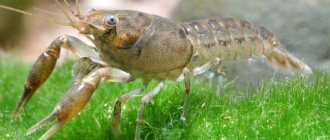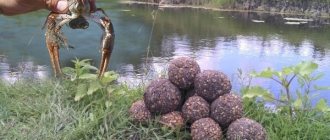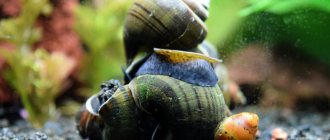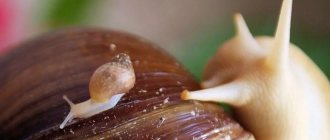Cancers are very interesting, unusual pets, and people keep them in their homes for a variety of reasons. Some owners strive to diversify their domestic fauna with exotic creatures. Others are ruled by gastronomic interest, because crayfish meat is a real delicacy. But every owner of an “armadillo” asks the question: how do crayfish reproduce? In captivity, these beauties with claws live no more than 5 years - by human standards, not so much. Will crayfish be able to leave offspring living in the most ordinary aquarium?
Sexual dimorphism
This is the difference in the anatomical structure of female and male individuals of the same biological species. In arthropods it is not expressed very clearly. Cancers most often have 2 sexes, they are characterized by sexual dimorphism. Males are equipped with a narrower abdomen (abdomen), but they have massive claws, unlike females. In the latter, the legs close to the cephalothorax, located on the abdomen, are underdeveloped. The remaining limbs are intended for movement and bearing offspring.
It is not difficult to distinguish a female crayfish from a male one if you are familiar with the basic differences.
Cancers are characterized by external fertilization and reproduce by spermatophores (capsule with sperm). Females are significantly smaller than males in size; they are miniature, with graceful shapes. Its claws also correspond to them; a female crayfish can be distinguished from a male by its small limbs. Its abdomen is much wider than the head part of the body, whereas in males it is narrow.
The abdominal limbs of the pair of arthropods also differ. Males have strong, well-developed legs, unlike females. The cover color of the crayfish determines the habitat and composition of the water. The color of the animal allows it to blend in with its environment and “dissolve” among the snags and silt. Common types of crayfish have a brown, brown-green or bluish tint.
The lifespan of crayfish has not yet been established; it is a mystery to scientists. Some experts claim that decapods (ten-legged) are able to live up to 10 years of age, others suggest even more - 20-25 years. There is no general opinion. The average lifespan of crayfish in an aquarium rarely exceeds 7 years.
How to choose the right pair
For reproduction, only sexually mature individuals capable of producing offspring are selected. A female cancer should be 3-6 years old, up to 12 centimeters long, weighing up to 60 grams. A sexually mature male is 2–4 years old, slightly larger than a female. The maximum fertility of ornamental species in most cases depends on the size of the female.
Male and female orange crayfish.
A large, adult individual is capable of bearing a large number of eggs. Readiness for mating can be determined by the appearance of the animal’s genitals: the male’s seminal glands become longer and milky white in color. Also, the first 2 pairs of abdominal legs change (they take part in mating), turn white and swell.
It is better to take a female with enlarged appendages (ovaries), this is a sure sign of readiness for reproduction. Mature eggs become brown in color. Before launching a “married couple” into the water, you should make sure of excellent physical health: the crayfish must actively work with their claws.
Differences between females and males
Determining gender is not easy:
- Girls are smaller than boys, but crayfish develop differently, so male and female crayfish may be similar in size.
- Males have thicker and longer claws and abdominal limbs.
- The first pair of legs in females is poorly developed or absent.
- The genital openings of the male are located next to the last pair of legs, in females - in the front part of the abdomen.
- A fertilized female is determined by the eggs of the offspring on legs.
Creating an enabling environment
Crayfish are excellent breeders in artificial ponds and also thrive in home aquariums. This is an excellent option, since you can independently set the optimal temperature for growth and reproduction. There are also disadvantages of such breeding - limited storage area, the need for frequent cleaning of the aquarium. However, if the decision is made, you should know the following rules:
- Crayfish need a spacious container with an airtight lid.
- Water must be hard, at a temperature of 18–20 degrees.
- Constantly monitor the purity of the water and parameters.
- The bottom of the reservoir should consist of soil mixed with river sand and pebbles.
- Crayfish love to hide, so you need to place pipe cuttings and pieces of wood with knots at the bottom of the container.
- Arthropods should be fed with high-quality, fresh foods. The diet should consist of minced meat, larvae of various insects, grated carrots, boiled potatoes and other things.
- It is necessary to have an incubator for jigging, where the offspring develop and grow. Adults can eat their offspring and weakened brothers.
Shelters for babies are one of the most important conditions for survival.
It is advisable to change the water more often, but not more than a quarter of the volume. For these purposes, it is better to leave it for 6-10 hours, since the chlorine used to disinfect water can poison animals.
Conditions in the breeding aquarium
Breeding aquarium crayfish does not require special experience or much effort from the owner. It is enough to take care of equipping the crayfish’s home, and then nature will do everything itself.
Crayfish are bottom-dwelling creatures, so the wider the aquarium, the better. Height is not so important for these animals, but the total volume of their home should be at least 150 liters. A prerequisite is a regular supply of oxygen and high-quality cleaning of the aquarium.
For successful breeding of crayfish, it is necessary to create shelters for them, for which a variety of tubes are perfect.
It is recommended to cover the bottom with river sand, small colored pebbles, driftwood, pipes and pots - in short, everything in which the crayfish will swarm and where they can hide. The optimal water temperature in the aquarium for reproduction is 18-20 ° C. Lower temperatures will cause the crayfish to slow down its development and go into hibernation. And some species of aquatic organisms may even die from hypothermia.
If your plans include breeding aquarium crayfish, you need to stock up on a few more containers in advance. Alas, crayfish sometimes turn into cannibals and eat their offspring.
Crayfish mating process
The mating season for arthropods begins in the fall. Reproduction in captivity requires the presence of 2 females and 1 male. If there are more females, then there is a risk of the female being eaten by the male. Before mating, crayfish molt, and the released pheromones (external secretion products) dissolve in water to stimulate the sexual desire of males. Having felt the signal of love, the animal begins to look for the source of the fragrance. He actively crawls along the bottom, looking for his mate.
00:30
Mating games of Orange Mexican Dwarf crayfish
Before mating begins, the “gentleman” begins to court his “lady”. He touches her with his long antennae, as if caressing her. Then everything happens according to the classical scheme: the male, having found the female, pursues her and catches up with her. To avoid injury during contact, he grabs the female's claws with his claws and presses them to the bottom. Then he turns it upside down and climbs on top.
The mating process of orange crayfish.
It turns out that when both individuals mate, they are in a belly-to-abdomen position. This allows the sex seed of the cancer to attach to the surface between the pseudopods - in the area of the 5th pair. After this, the main stage of reproduction is over, fertilization of the eggs occurs exclusively externally. Further, the male individual is not involved in raising the offspring. The mother takes care of everything.
Differences between females and males
Determining the sex of cancer is quite difficult. Despite the clear distinction by gender, many creatures have both female and male characteristics. Although ideally, the genital openings of crayfish should differ in their location. In males, tubular structures grow next to the last pair of walking legs. And the sexual characteristics of females (gonopods) are located in front of the third pair of legs (counting from the last).
Female crayfish are usually smaller and much more graceful than their counterparts. Although it happens that a frail male is mistaken for a sophisticated lady, that is why the size of crayfish is not always a correct indicator. The best way to distinguish a female crayfish from a male is by its claws and tail. Boys have more powerful and long claws, but the tail is not as wide as that of females. Girls also have a fairly wide cephalothorax and body, and their first abdominal limbs are either miniature or simply absent (after all, they do not need to firmly hold the male during mating).
Very young and small-sized ladies are considered poor producers: they carry too few eggs!
Carrying eggs
20 days pass after mating, only then the female lays eggs. Fertilized eggs stick to the false legs on the abdomen. There they remain until hatching. Crayfish carry their young on pleopods (swimming limbs) all winter, until May-June, which is approximately 230 days. This is the most difficult period for the arthropod: you have to constantly work with your tail, pushing fresh air to the larvae.
Crayfish eggs are securely attached under the female's tail.
It is also necessary to protect your offspring from attacks by predators, to clean mold, various contaminants, and growths of aquatic vegetation from the abdomen. When these hygiene procedures occur, a certain percentage of the eggs detach and die. Dead capsules with embryos turn yellow. This happens even during the attachment of eggs.
Many more eggs are lost for other reasons: fish sometimes try to grab protein-rich food, embryonic development stops, mechanical detachments. All these losses take up about half of the clutch formed in the ovaries. This directly depends on the habitat of the animals, where the percentage of waste ranges from 20 to 70. Crayfish larvae are released from the shell in May - July (depending on the type of cancer), when the water warms up to a temperature above 20 degrees.
Egg-laying always occurs at night and lasts about 3 hours. One clutch can contain from 100 to 150 eggs.
Business plan
To understand how profitable it is to breed and sell fingerling crayfish, it is recommended to do some calculations. So, there is an area of 25 square meters. m. 200 crayfish are placed on it, weighing about 30 kg. This number of arthropods will require 600 grams of food per day. In a year and a half, the mass of crayfish will double, and the cost of food will reach a maximum of 4,000 rubles. Crayfish will reach marketable weight only by three years. A kilogram of crayfish costs about 500 rubles on the market. In a year and a half, it turns out that the profit will be approximately 25,000 rubles per month.
Young crustaceans
Newly hatched babies are very small, however, they are fully formed living beings. When babies are born, they are only 5 to 9 millimeters long. Freed from the shell, the crustaceans hang on the legs of their mother. After the first moult they leave their shelter. They move a short distance, but if they suddenly sense danger, they quickly swim back and hide under the female’s abdomen.
The fry hide under the female's tail from any troubles.
The fry feed on the same food that the adults eat. Various organic wastes found in aquariums and ponds become food. You can feed the young with dry industrial mixtures for fish fry, cut into pieces tubifex worms, and small Artemia crustaceans. When artificially propagating, a herd of newborn crustaceans must be kept separate from adults.
Grown-up cubs are sent to the teenage department. Then the youngsters are dropped off with adult animals. In small crustaceans, it is impossible to determine the sex, since the organs have not yet formed. Crayfish molt many times over the years of their existence. The first year - 1, the second year - up to 4, the remaining period - 2 times. In captivity, this process occurs much more often.
Comfortable living conditions allow crayfish to grow not in four, but in 2 years. From this we can conclude: if you want to breed healthy, active juveniles, it is advisable to acquire a spacious aquarium. It should have a sufficient bottom area and a variety of shelters - shards, driftwood, stones. Since small crustaceans often shed during the first months, they should be provided with reliable protection and plenty of high-quality food.
Cannibalism “thrives” among these animals, and there is a risk of being eaten by one’s own relative. Hobbyist breeders often use building bricks with voids as shelters. They are cheap and provide young crustaceans with a large number of minks. It is also advisable to equip the bottom of the container with dense thickets of algae.
A small crustacean is a tiny copy of its parents from the very moment it is born.
The process of breeding crayfish, of course, takes time and labor, but the results are always positive. These arthropod inhabitants of reservoirs are an interesting object of observation, for which you do not mind your time.
Mating crawfish games
Before mating, females usually moult. At the same time, special substances - pheromones - are released into the water to attract males. Having received such a signal, the gentleman immediately goes in search of his lady and begins to wander around the aquarium. Before mating occurs, the male “courts” his partner, touching her with special antennae.
Then suddenly the cancer will begin to follow its natural instincts and “catch” the female, but not with its claws, but with its abdominal legs, which are also quite strong and dexterous. From a romantic tramp, cancer turns into a real hunter, ruthless and persistent. He wraps his legs around his girlfriend and presses against her with the tubular holes on her body. Crayfish usually mate in a fierce struggle: the male holds the female, who resists with all her might, trying to escape. And here everything depends on the size of the future parents. If a male crayfish is inferior to his partner in strength and growth, fertilization may not occur. But if the gentleman is too strong and strong, he can easily kill the girl during the process, and with her the future offspring - the fertilized eggs.
After successful mating, the crayfish girls with fertilized eggs return to their shelter and try not to leave there during the daytime, while the anxious males continue to look for love affairs. Under the power of natural reproductive instincts, a male crayfish can successfully fertilize 2-3 partners, after which he languishes from exhaustion and hunger. It costs him nothing to turn on his ancient instinct and dispassionately devour his last fertilized girlfriend after intercourse.
After fertilization, the male's role in the development of the offspring ends. All worries fall on the fragile “lady’s shoulders,” or rather, on her tail.
Useful tips
Experienced crayfish fishermen recommend using some tips to help you catch crayfish.
You need to know the following features:
- Crayfish have a highly developed sense of smell, which is why they use baits that emit a particularly strong odor. The smell of garlic is especially attractive to arthropods. Many crayfish fishermen rub garlic on a piece of brick and then place it in the trap. After some time, the crayfish will definitely fall for the garlic aroma that attracts them so much. If the smell is not strong enough, especially for vegetable baits, it is recommended to flavor them with garlic juice.
- It is best to catch crayfish from July to December; it is at this time that arthropods gain greater mass, and caviar deposits form in females. Use bait of animal origin. They also rub the bread with garlic, wrap it in cheesecloth, and place it in a trap.
- The bait (with the exception of shellfish) is firmly fixed to the bottom of the crayfish trap. A pocket of nylon fabric is sewn into the bottom of the trap. Sometimes they use a large bait, securing it with a rubber band.
- When using fresh fish for bait, it is first cut lengthwise. This is required to attract arthropods with the smell of meat and blood of fish.
- It is recommended to go hunting for crayfish in places where ponds are located near poultry farms. Meat production waste often ends up in such reservoirs, which can result in a huge number of crayfish in these places.
Catching crayfish is considered a very interesting and exciting process, because in this case the crayfish catcher awakens passion and the desire to catch as many individuals as possible for further delicacy. If you know where and when crayfish are found, and what traps and baits to use to catch them, luck will not turn your back.
0
0
Copy link
Time
Every crayfisher who decides to go hunting should know what time to catch crayfish. This is necessary in order not to waste your personal time. Crayfish are caught in the dark, when they go for prey - from 22-00 to 3-00. There are reservoirs where crayfish go out in search of food in the early morning.
It is difficult to answer clearly what time to catch crayfish, because different regions have their own deadlines. It is believed that you can catch delicious crayfish in the autumn. It is from the end of August to the end of October that crayfish have delicious and fatty meat. But in the spring, during spawning, catching crayfish is prohibited by law.











